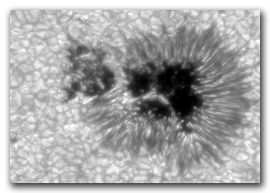Solar Physics

Our main goals are to identify the processes whereby magnetic flux appears on the solar surface; to understand the mechanisms governing the evolution of the magnetic field on short, medium and long time scales; and to determine the role played by the magnetic field in the coupling of the various layers of the solar atmosphere. We are particularly interested in sunspots and quiet Sun magnetic elements, both in network and internetwork regions.
To achieve these goals we use state-of-the-art spectropolarimetric measurements at high spatial resolution and sensitivity, taken by ground-based and space-borne instruments, and analyze them with the help of inversion codes of the radiative transfer equation.
With a view to infer the properties of the solar plasma more accurately, we also work on the theory of radiative transfer of polarized light in stellar atmospheres. We have developed two new Stokes inversion codes. The MILOS code is based on Milne-Eddington atmospheres, while the SIRJUMP code is able to deal with discontinuous stratifications of the physical parameters along the line of sight. Both codes have been successfully applied to high-resolution spectropolarimetric observations taken by the japanese Hinode satellite.
The group is also involved in the design, development, and construction of advanced solar instrumentation. We were responsible for the electronics and software of the IMaX magnetograph that flew aboard the SUNRISE solar observatory in 2009 and 2013. Currently, our group leads the development of IMaX+, a new magnetograph for the third flight of SUNRISE in 2020. Furthermore, we co-lead the international consortium building SO/PHI, the magnetograph of ESA's Solar Orbiter mission to be launched in 2018. We also develop instruments for ground-based telescopes, particularly the future European Solar Telescope now in its design phase.
Combining these two fields of expertise, the scientific and the technological, our group has recently opened a new research line aimed at building electronic devices for the inversion of the radiative transfer equation. One such device will perform the analysis of the observations carried out by SO/PHI before being transmitted to the Earth.